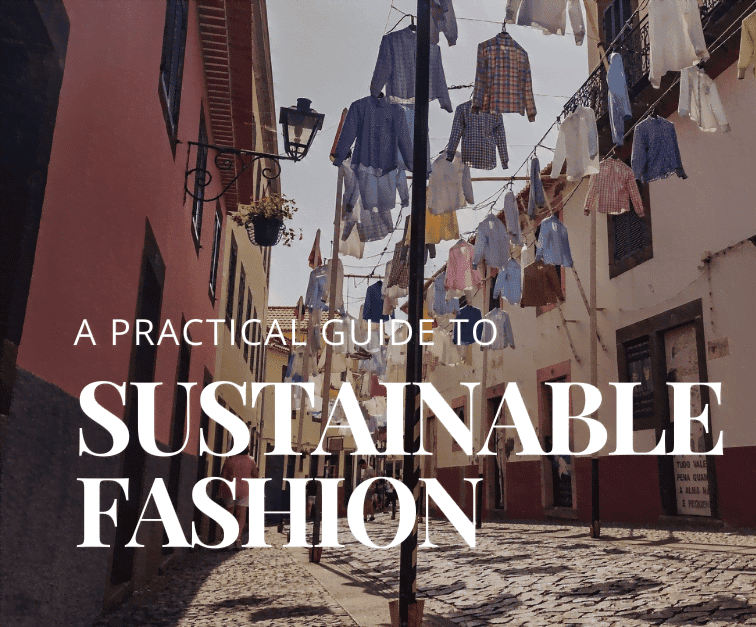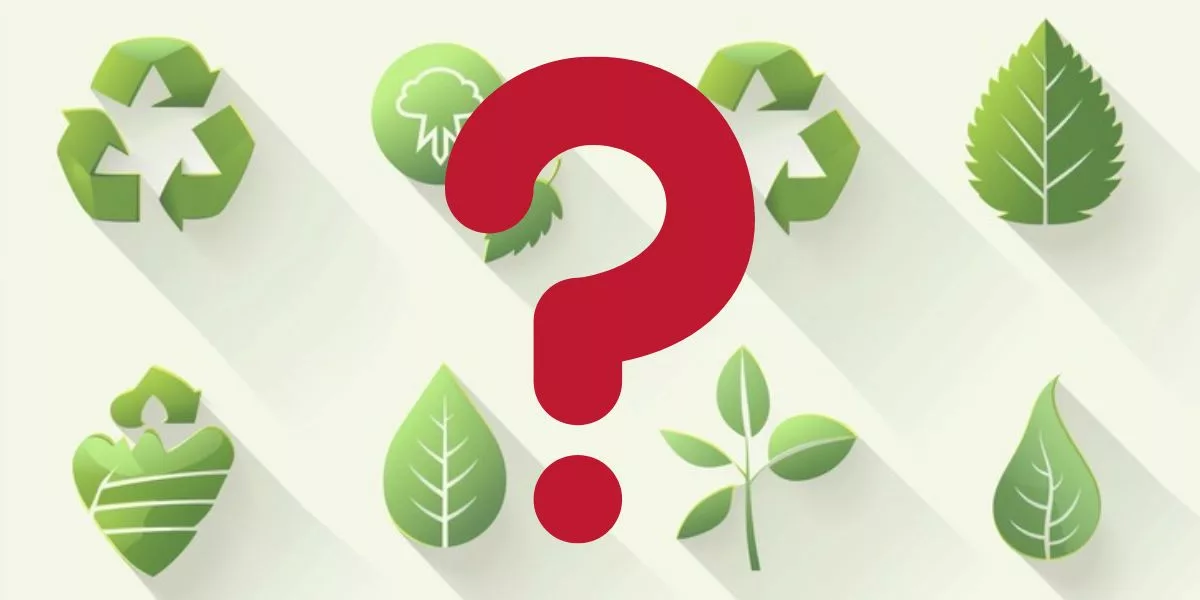Last Updated on August 1, 2024 by Shavy Jain
Executive Summary: Increasing worries regarding environmental challenges and the imperative to conserve natural resources, alongside heightened societal expectations, have propelled sustainability into the forefront for both green consumers and organizations. This comprehensive research initiative details how sustainability influences consumer purchasing behaviors and assesses the extent to which organizations grasp and fulfill these expectations.
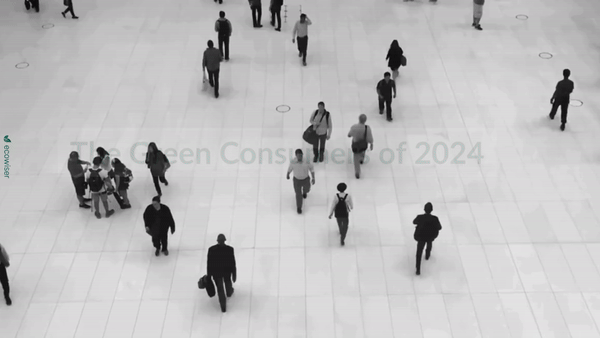
Key Findings
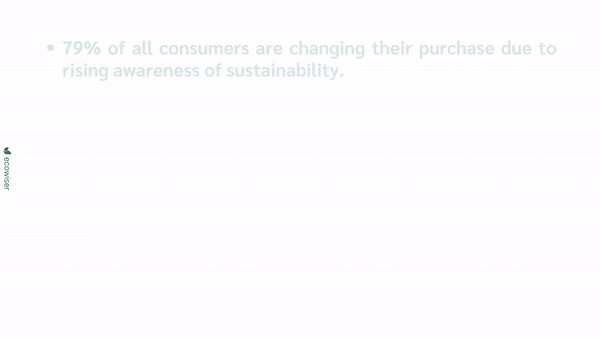
79% of all consumers are changing their purchase due to rising awareness of sustainability.
However, only 36% of organizations that believe green consumers are willing to make such changes based on social or environmental impact. This disparity poses a risk to approximately 6% of brands’ and retailers’ revenue if left unaddressed.
Green consumers actively integrate sustainability into their daily lives.
By minimizing food waste and using energy-efficient appliances. This behavior extends to their shopping habits, where they prefer products with minimal packaging. Emotionally, purchasing sustainable products often evokes positive feelings like happiness, highlighting sustainability’s potential to enhance customer experience and loyalty.
COVID-19 has been a game changer in bringing these issues to the surface.
Green consumers now weigh safety considerations against sustainability goals. This is evident in reduced demand for used or refurbished products due to concerns over “touch-based” practices, i.e online shopping.
Yet, there remains strong consumer commitment to sustainability.
- 65% are open to purchasing non-plastic alternatives despite COVID-19.
- 68% express a desire to support local products, seeing them as a blend of safety and sustainability.
- Moreover, consumers expect companies to maintain their sustainability efforts during these critical times.
- A significant majority (77%) believe that sustainability initiatives foster customer loyalty, with 63% reporting revenue growth as a result.
The Age of The Green Consumers
Sustainability should be at the forefront of 21st-century product placement.
Why? People want green goods. And more importantly, they want green brands to talk about their offerings.
Nearly half of consumers are interested in buying products that aid in planet preservation. Not to mention, 1/3rd are on board for paying premium rates for green services and products. This is great news for brands. But that’s not all. Benefactors, businesses, and buyers — all stand to gain from the adoption of sustainable messaging. The stats mentioned above underscore a substantial opportunity for businesses to capture market share by aligning with green consumers’ increasing inclination to switch based on sustainability principles.
The market’s shift towards sustainability is not a fluke or a trend, but a solid movement towards adopting models that reflect their commitment to people and the planet.
To track this gradual progress, Ecowiser interviewed 789 consumers from North America about their purchasing habits. Here’s what we found!
Navigating Sustainability: Understanding Consumer Awareness and Action
The landscape of sustainable product and service consumption is varied, with a majority (59%) engaging as occasional or regular consumers, indicating a solid and growing market. However, the data also reveals a significant portion is still unfamiliar or not consuming, highlighting the need for increased awareness and engagement.
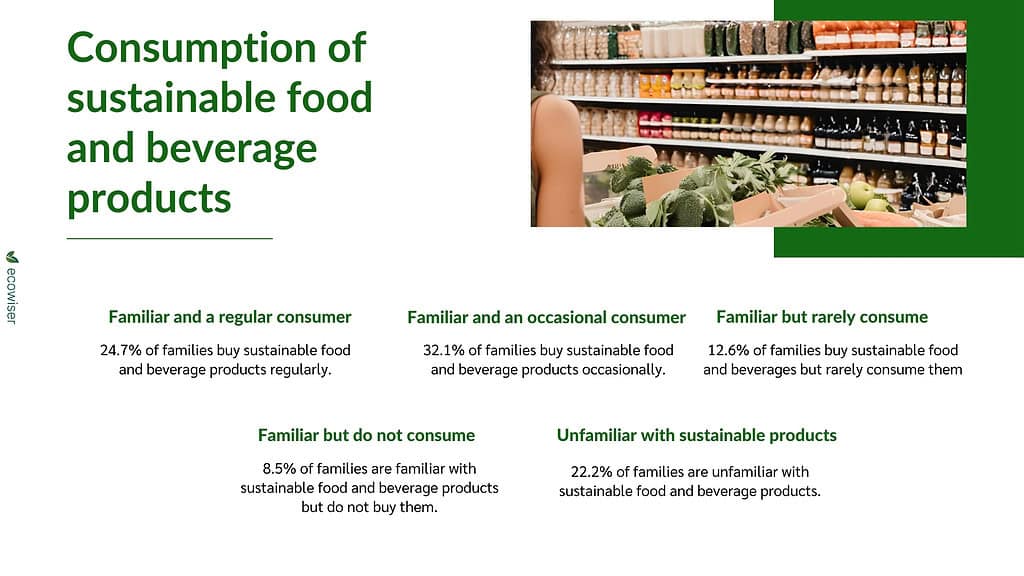
There is a great opportunity to create a large segment (about 56.8% of people) of regular sustainable consumers. To address this, focusing on educational marketing that demystifies sustainable products and showcases their benefits could help. For those already on board, reinforcing their habits with rewards or information on the broader impact of their choices is an option.
Age-Related Consumption Patterns in Sustainability: Insights into Sustainable Savvy
As consumers age, there’s a notable shift in familiarity and consumption habits with sustainable products. The older the demographic, the greater the portion of individuals who are unfamiliar with sustainable options. Concurrently, the number of regular consumers of sustainable products decreases, while occasional consumption sees an uptick. Interestingly, the group that is familiar with but actively chooses not to consume sustainable products diminishes with age.
This trend highlights a critical need for targeted education and engagement strategies across age groups. For younger, more regular consumers of sustainability, maintaining and innovating in product offerings is key. Conversely, for older demographics, increasing accessibility and awareness, along with emphasizing the relevance and benefits of sustainable products, can help convert occasional consumers into regular ones and increase overall familiarity with sustainable options.
Sustainability Perspectives For Green Consumers Across Income Tiers
The awareness and understanding of sustainability appear to be uniformly distributed across different income segments, suggesting that the concept of sustainability has penetrated broadly and deeply into consumer consciousness. This universal familiarity has been verified by Harvard Business Review, as it presents a solid foundation for brands to build upon, regardless of their target income demographic.
With sustainability awareness nearly uniform across income segments, brands can universally target their eco-conscious products. This even distribution means there’s potential in every market tier. By focusing on innovative and sustainable offerings, brands can captivate a broad audience, transcending income barriers. It’s a strategic opportunity to connect with consumers universally, harnessing the power of sustainability as a key driver of appeal and loyalty.
Factors Influencing Sustainable Consumer Choices
Consumers are motivated by a rich tapestry of reasons to choose sustainable products, with health benefits (58.6%), environmental concerns (39.8%), and taste preference (45.3%) leading the charge.
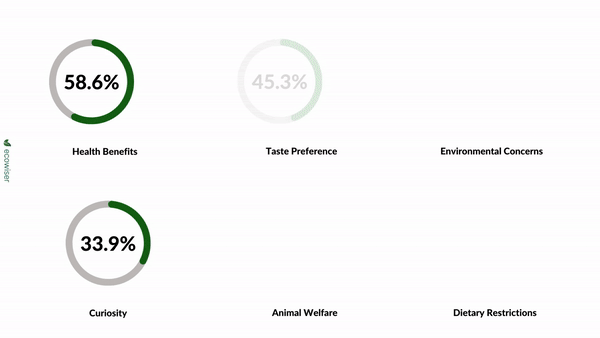
Capitalizing on the growing trend, savvy brands can harness the powerful association between sustainability and health. Highlight the variety of benefits your products offer to cater to these motivations. Emphasize delicious tastes, healthy advantages, and the positive impact on animals and the environment in your messaging.
Green Info Hunt: Sources and Channels for Consumer Sustainability Education
The quest for information on sustainability is predominantly digital, with online articles, blogs (56.2%), and social media platforms (48.2%) serving as the primary sources. Documentaries, educational programs, and personal recommendations also play significant roles, reflecting a diverse set of channels through which consumers educate themselves and make informed decisions.

Cultivating Change: Consumer Aspirations for a Greener Market
The 21st-century consumers keep making it clear that they want options for affordable and available sustainable products in the market. Along with affordable pricing, their priorities include availability and variety. There has also been a strong call for enhanced taste and quality, along with heightened transparency standards and a complete rejection of misleading marketing.
To meet these demands, companies must focus on adjusting their pricing model, expanding distribution, and bringing out a diverse range of offerings. They should also work on communicating their offering to the general public, and building trust within the market.
Ecowiser helps green brands in marketing their products by building their offering and refining their messaging, so they have a chance to stand out in a crowded market. Make Ecowiser your growth partner today.
Age-Related Shopping Trends: Diverse Preferences in Sustainable Consumption

The millennials are waking up to a new found purchasing power, and they want to be wiser decisions with their wallet. While younger and older spectrums of consumers favor the cheap, easy, and accessible, the mid-age range prefer supporting local businesses, the farm to table movement, and investing in quality products that don’t come at the cost of harming the planet.
Brands should consider dynamic and multi-channel communication strategies that cater to the different value sets. For younger and older generations, building a robust online presence is a must. Meanwhile, middle aged groups should be served with B2B partnerships, straightened messaging, and alignment in planet-favorable values.
Sustainable Shifts: Consumer Trending Towards Sustainability
74.8% of all consumers are moving towards more sustainable choices over the past couple of years. This shift shows up in marketing and greenwashing as well. There’s a silent race to appease the green affiliated crown.
It’s crucial for brands to seize this moment and reinforce their sustainable offerings. The job isn’t just to service the converted consumers, but to also lure in the rest of the 22% crowd by presenting the personal and global benefits of sustainable products.
Green Tide Rising: Advancements in America’s Sustainable Practices
Americans are the leading consumers of green products and are 5% ahead in amping up their sustainable purchases as compared to 70% of Canadians. This subtle yet significant boost is a great sign of green capitalism and eco-forward trends trickling down to the rest of the world.
For brands, it’s not enough to maintain but also intensify sustainable practices and offerings. With the rise of green demand, brands need to be innovative and practice what they preach. It’s no easy feat to capture the attention and loyalty of an increasingly eco-engaged American audience. This is why brands can’t take their peddle off the gas anytime soon.
Accessibility Matters: Enhancing Access to Sustainable Options
Sure, green products have an increasing demand, but are they accessible and available to the public? Only half of consumers find green products somewhat accessible, and the rest have testified that there are significant barriers to its availability. This is an opening for brands who want to expand their customer base.
It’s also important to improve the accessibility of your products through pricing, distribution, and messaging if they wish to penetrate young markets. By making it easier for consumers to choose green, brands can enhance their appeal and become a leading alternative over the substandard goods that are harmful to the planet.
Perceptions and Potentials in Sustainable Products
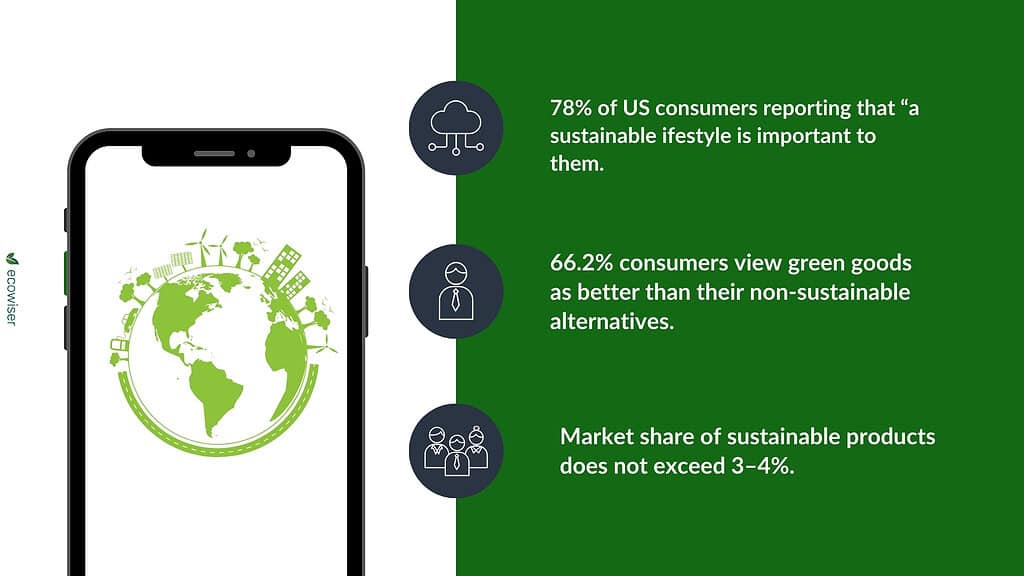
Houston, we do have a perception problem! Only 66.2% of green consumers view green goods as better than their non-sustainable alternatives.
It’s crucial to build upon this number by emphasizing on the superior quality and benefits of your sustainable products. It’s also important to ascertain the uncertainties by maintaining transparency and providing clear, compelling information, wherever possible.
Age and Impact On Eco-Social Living
When it comes to green purchases, age matters. The urge to make environmental and social impact decisions increases with age. The number starts with only 12.9% in those under 20, and it triples to 34.65% for green consumers aged 60 and beyond. This steady progression is often seen as a result of life experience, exposure to climate news, and a responsibility towards their offsprings and future generations.
Brands need to take this as a cue to emphasize and communicate their environmental and social initiatives. It can’t be just business as usual. The marketing has to mean more.
Gender Perspectives: Women’s Leading Role in Eco-Social Awareness
Women consumers show a higher concern for social impacts of their shopping and spending habits. This slight edge shows up in several surveys. Women are also generally more receptive to finding new brands that are channeling sustainability and ethics.
Brands should be making use of this insight by building targeted campaigns by highlighting the positive eco-social impact of their products. Engaging with women is the fastest way to penetrate new markets with causes that align with women’s values.
Trust in Labels: The Influence and Importance of Certifications
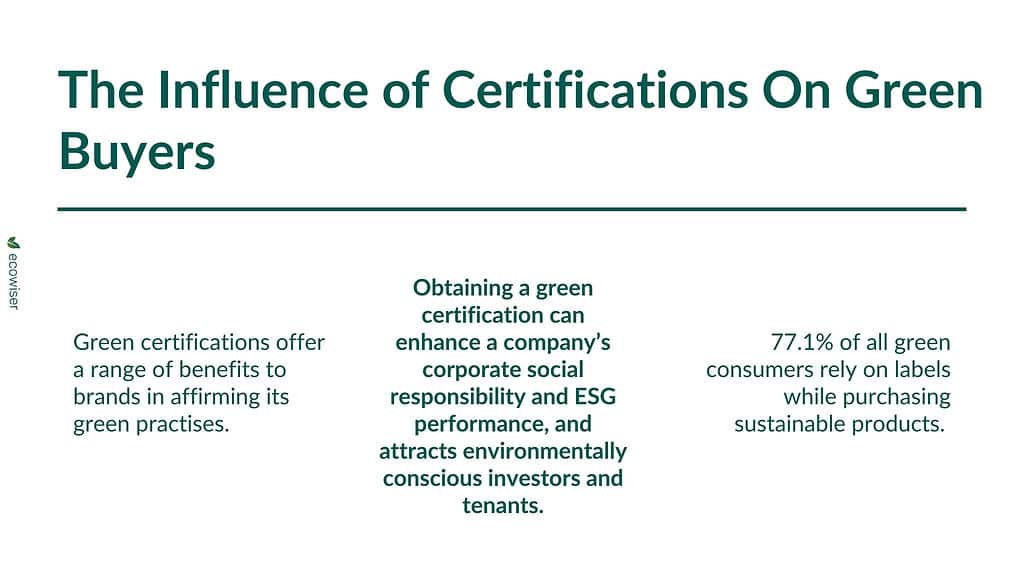
Certifications and labels play a crucial role in building consumer trust. 77.1% of all green consumers rely on labels while purchasing sustainable products.
This underscores the importance of having credentials that show up like a report card for your green performance.
To build this trust, make sure that your products are meeting industry standards, and showcase the relevant certifications to build trust with the audience.
At Ecowiser, we believe in the power of sustainable practices to transform businesses and the planet. Join us in making a difference while boosting your brand’s visibility and credibility.
Get evaluated with our proprietary rating system and earn Wiser Badges to showcase your sustainability efforts. Check out our process here.
Age and Assurance: The Increasing Significance of Certifications Across Generations
As green consumers get older, they place more importance on certifications like USDA Organic or Fair Trade for sustainable products. While 70% of those under 20 value these assurances, the number jumps to an impressive 91.43% for those over 60. This trend highlights a growing desire for quality, authenticity, and trustworthiness in sustainable purchases as people age, likely driven by increased health, environmental, and ethical considerations.
For brands, this means there’s a significant opportunity to invest in and prominently display credible certifications in their product offerings, especially when targeting older demographics. Understanding and emphasizing the value of these certifications can be a key differentiator in attracting and retaining mature customers.
Seal of Trust: America’s Call for Recognized Sustainability Certifications
Americans find USDA Organic, Fair Trade, and similar certifications about 6% more appealing than Canadians do. This shows a stronger American trust in and demand for validated sustainable practices.
Brands wanting to succeed in both the U.S. and Canada should emphasize these certifications in their product lines. Highlighting these seals of approval can be a game-changer, providing a clear, trusted signal of quality and sustainability that resonates with American consumers’ preference for authenticated eco-friendly options.
Price vs. Purpose: Evaluating the Financial Considerations of Sustainability
Price is still a key factor in sustainable purchasing decisions, with almost 40% of all green and non-green consumers choosing sustainable options when the price is right. However, a dedicated 21.7% are willing to pay more, putting sustainability above cost. This means a significant portion is still price-driven, emphasizing the need for affordable sustainable options.
To appeal to a wide range of green consumers, consider strategies like price matching, emphasizing the long-term savings or value of sustainable products, and offering promotions.
How Income Insights Matter While Spending On Sustainability
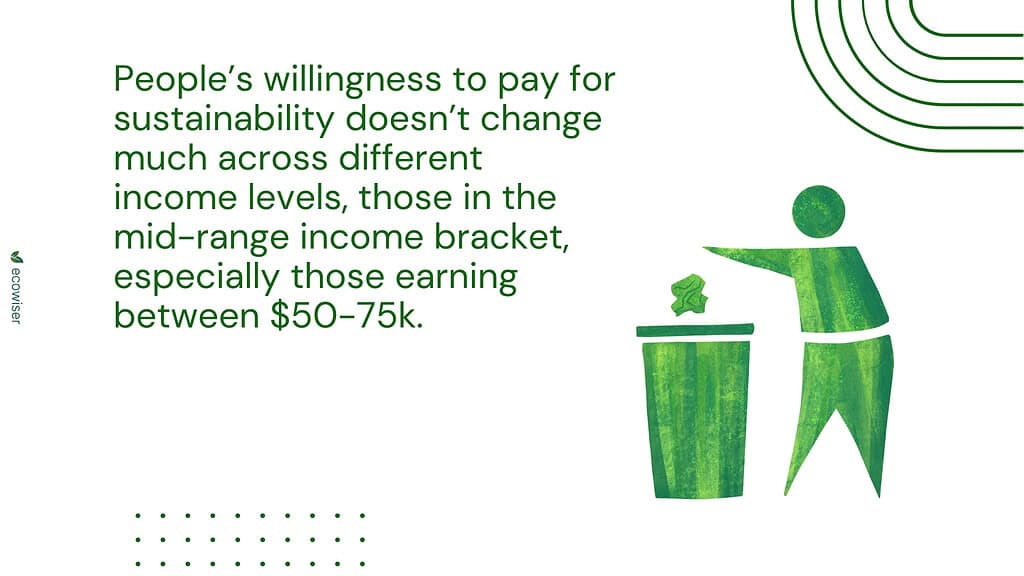
Interestingly, while people’s willingness to pay for sustainability doesn’t change much across different income levels, those in the mid-range income bracket, especially those earning between $50-75k, are notably more ready to spend extra on sustainable products.
This means that targeting mid-range earners with your sustainability initiatives and product offerings could lead to better engagement and a stronger market share in this demographic.
Age and Value: Changing Priorities in Sustainable Expenditure
As people get older, they tend to shift from just looking for the cheapest option to seeking more value, which means they’re increasingly interested in sustainable products that are still reasonably priced. This shows they’re balancing cost with their ethical values.
For your brand, this is a great opportunity. By offering sustainable products at competitive prices, you can attract these green consumers who are looking for that perfect mix of affordability and eco-friendliness.
How To Market Sustainable Practices To Attract Green Consumers
You can create marketing campaigns that show the embrace of sustainability practices. But showing your commitment to green practices goes beyond a sprinkle of buzzwords in your copy.
Before we begin, it’s important to note that green messaging, without the rightful backing with actions, is greenwashing. And that’s something you need to be very cautious about.
Don’t take this lightly.
If there’s anything that conscious customers dislike more than spending money on brands that are harmful to the planet, is spending money on brands that are “claiming” to help the planet, but instead are causing it harm.
You don’t want to be one — or your brand will be completely written off by your customer base.
Remember, conscious practices must precede your green marketing efforts.
If you have already incorporated, or are looking to incorporate green initiatives in your business, here’s how you can channel it in your marketing.
- Build trust: If you want to convince customers to shell up some extra dollars for your product/service, then you need to build trust. This is the first step — although it can take years to accomplish this. Check out Ecowiser to figure out how we rate green products.
- Create a sustainable brand story arc: Pool all the reasons why the brand is developing a meaningful and authentic sustainability message. Then, launch the message that resonates with the audience.
- Align your values with actions: Make sure that your actions are in line with your intentions, and that you are aligned with the brand’s core values.
- Educate your team members and bring them to the same: Your employees must be educated on the sustainability arc of your company, and you must educate them — so they can represent you well. This can be done by fostering a culture of sustainability from within.
- Get government mandates: Enter into government forums and get the government seal of approval that can be showcased to the public. Show how businesses have garnered sustainability achievements over the course to build trust with your customers.
- Collaborate with Like-Minded Partners: Forge partnerships with organizations or initiatives that share your sustainability values and collaborate to amplify the impact of green messaging.
- Advertise incremental progress: Showcase relevant metrics and key performance indicators (KPIs) that your business is tracking to showcase its commitment to sustainability.
- Engage your customers: Explain how your brand is actively engaging with the audience and helping them with their sustainability efforts. You can also create content and market your services through loyalty programs, feedback channels, and initiatives that encourage eco-conscious behavior.
- Share case studies and success stories: Include real-world case studies and success stories that illustrate your brand has successfully helped in advancing the grave issue of climate change, and mitigating its impact.
Summing Up!
Do people care about sustainable goods?
Yes. They do. In fact, nearly 42% of customers have stopped buying products due to their environmental impact. And they want to exchange their money for products and services that care about something more than their corporate profit.
So yeah, the best way to stay relevant in this increasingly evolving world is by being ecologically and socially responsible.
Because customers now prefer businesses that are taking a lead on sustainability.
But there’s a risk in this. You see, the customer is non-homogenous, and they are smart. Nearly 64% are now aware that there’s an entire category of brands that are parroting the message of sustainability to stand out and be distinctive from their competition. In the guise of appearing to be “sustainable,” businesses are just lining up their pockets. Ouch!
Therefore, authenticity in sustainability is crucial. Businesses must genuinely commit to sustainable practices, as today’s savvy consumers can easily spot insincerity. Real commitment to sustainability not only attracts and retains customers but also builds trust and long-term loyalty. In the end, truly sustainable businesses will thrive, while those only pretending will eventually be exposed.


